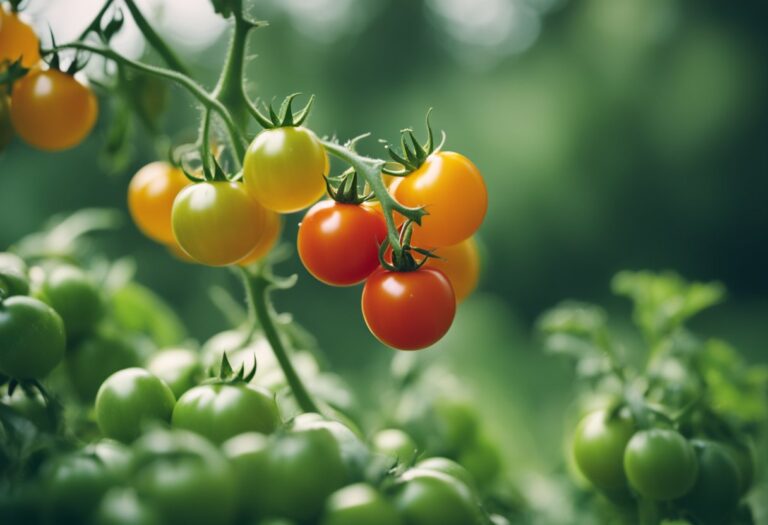Tomato Plants Wilting: Causes and Solutions
If you’re a tomato gardener, you know how frustrating it can be to see your tomato plants wilt. Wilting is a common problem that many tomato plant owners face. It can be caused by a variety of factors such as drought, heat, fungal diseases, bacterial wilt, and even overwatering. Understanding the causes of wilting is essential to prevent it from happening in the first place.
When your tomato plants start to wilt, it’s important to diagnose the issue quickly. Some causes of wilting can be easily resolved, while others require more serious damage control.
In this article, we’ll cover everything you need to know about tomato plant wilting, including how to diagnose the problem, how to revive wilted tomato plants, and expert tips for tomato garden care. With this knowledge, you’ll be able to keep your tomato plants healthy and thriving all season long.
Key Takeaways
- Understanding the causes of tomato plant wilting is essential to prevent it from happening in the first place.
- It’s important to diagnose the issue quickly when your tomato plants start to wilt.
- Reviving wilted tomato plants and maintaining a healthy tomato garden requires expert knowledge and care.
Understanding Tomato Plant Wilting
If you’re growing tomato plants, you might encounter the issue of wilting. Understanding the causes and signs of unhealthy tomato plants can help you take the necessary steps to prevent or address wilting.
Common Causes of Wilting
Tomato plants require proper care and attention to thrive. One of the most common causes of wilting is incorrect watering. Overwatering or underwatering can cause the tomato plants to wilt. It’s important to water the plants regularly and consistently, ensuring that the soil is moist but not waterlogged.
Another common cause of wilting is pests and diseases. Tomato plants can be affected by various pests and diseases, such as aphids, spider mites, and blight. These can cause the leaves to wilt and turn yellow or brown. It’s important to monitor your plants regularly and take steps to prevent or address any pest or disease issues.
Transplant shock can also cause wilting in tomato plants. When you transplant a tomato plant, it can take some time for it to adjust to its new environment. During this time, the plant may wilt or droop. However, this is usually temporary and the plant should recover within a few days.
Signs of Unhealthy Tomato Plants
In addition to wilting, unhealthy tomato plants may exhibit other signs of distress. These can include yellowing or browning of the leaves, stunted growth, and curling of the leaves. If you notice any of these signs, it’s important to take action to address the issue.
Inspect your plants regularly for signs of pests or disease, and take steps to prevent or address these issues as soon as possible. Ensure that your plants are receiving proper care and attention, including regular watering and fertilization.
By understanding the common causes of wilting and the signs of unhealthy tomato plants, you can help ensure that your plants thrive and produce a bountiful harvest.
Preventive Measures for Wilting
If you want to prevent your tomato plants from wilting, there are a few things you can do. Here are some preventive measures you can take:
Proper Watering Techniques
One of the most important things you can do to prevent your tomato plants from wilting is to water them properly. Overwatering or underwatering can both cause wilting.
Make sure you water your plants deeply and infrequently, rather than giving them frequent, shallow waterings. Check the soil regularly and water only when the top inch or two of soil has completely dried out.
Soil Quality and Composition
Another important factor in preventing wilting is the quality and composition of your soil. Tomato plants need well-draining soil that is rich in organic matter.
Make sure your soil is loose and friable, and that it contains plenty of compost or other organic matter. Avoid planting your tomatoes in heavy, compacted soil, as this can cause poor drainage and lead to wilting.
Appropriate Sunlight and Shade
Tomatoes need a lot of sunlight to grow and thrive, but too much direct sunlight can cause wilting. Make sure your tomato plants are getting at least 6-8 hours of direct sunlight each day, but also provide some shade during the hottest part of the day. You can use shade cloth or plant your tomatoes near taller plants that will provide some shade.
By following these preventive measures, you can help ensure that your tomato plants stay healthy and avoid wilting. Remember to check your plants regularly and make adjustments as needed to keep them happy and thriving.
Diagnosing Wilting Issues
If you notice that your tomato plants are wilting, it is important to diagnose the issue as soon as possible. There are a few common causes of wilting, including disease and pest infestations. By identifying the problem, you can take the necessary steps to save your plants.
Disease Identification
One of the main causes of tomato plant wilting is disease. Some common diseases that can cause wilting include fusarium wilt, verticillium wilt, and bacterial wilt. Symptoms of these diseases include yellowing leaves, stunted growth, and wilting.
To diagnose whether your plants are affected by disease, look for the following signs:
- Yellowing or browning of leaves
- Stunted growth
- Wilting or drooping leaves
- Discoloration or spots on leaves or stems
If you notice any of these symptoms, it is important to take action immediately. Remove any affected plants and dispose of them properly to prevent the spread of disease.
Pest Infestation Signs
Another common cause of wilting is pest infestations. Pests such as aphids, whiteflies, and spider mites can cause damage to your tomato plants, leading to wilting and other issues.
To diagnose whether your plants are affected by pests, look for the following signs:
- Holes or chewed leaves
- Sticky residue on leaves or stems
- Discoloration or spots on leaves or stems
- Presence of insects on or around the plant
If you notice any of these symptoms, it is important to take action to control the pest infestation. Use natural or chemical pest control methods to prevent further damage to your plants.
Remember, early diagnosis is key to saving your tomato plants from wilting. Keep a close eye on your plants and take action as soon as you notice any symptoms of disease or pest infestations.
Reviving Wilted Tomato Plants
If you notice your tomato plants are wilting, don’t panic! There are a few simple steps you can take to revive them. In this section, we’ll go over some immediate actions you can take as well as long-term plant health strategies.
Immediate Actions to Take
The first thing you should do when you notice your tomato plants wilting is to check the soil moisture. Stick your finger in the soil up to your second knuckle. If the soil feels dry, it’s time to water your plants. Water deeply to ensure the roots get enough water. Avoid watering the leaves as this can lead to fungal diseases.
If your plants are still wilting after watering, it’s time to take more drastic action. One option is to provide shade for your plants during the hottest part of the day. You can use shade cloth or even an old bed sheet to protect your plants from the sun.
Another option is to prune your plants. Remove any damaged or diseased leaves, as well as any suckers that are taking energy away from the main stem. This will help your plants focus their energy on producing fruit.
Long-Term Plant Health Strategies
To prevent your tomato plants from wilting in the future, it’s important to take steps to maintain their overall health. One way to do this is to make sure your plants are getting enough nutrients. Use a balanced fertilizer and follow the instructions carefully.
Another important factor in plant health is soil quality. Make sure your soil is well-draining and rich in organic matter. You can add compost or other organic materials to improve soil quality.
Finally, it’s important to choose tomato varieties that are well-suited to your climate. Some varieties are more resistant to heat and drought than others. By choosing the right varieties for your area, you can help ensure your plants stay healthy and productive.
Expert Tips for Tomato Garden Care
Growing healthy and productive tomato plants requires proper care and attention. Here are some expert tips to help you keep your tomato plants from wilting:
- Watering: Tomatoes need consistent watering to thrive, but overwatering can lead to root rot. Water your plants deeply once or twice a week, depending on weather conditions. Be sure to water the soil, not the leaves, to prevent fungal diseases.
- Fertilizing: Tomatoes are heavy feeders and require regular fertilization. Use a balanced fertilizer or one that’s high in phosphorus to promote healthy root growth and fruit development.
- Pruning: Regular pruning helps increase air circulation and sunlight exposure, which can prevent fungal diseases and promote healthy growth. Remove suckers (the small shoots that grow between the main stem and branches) and any yellowing or diseased leaves.
- Mulching: Mulching helps retain moisture in the soil and suppresses weeds. Use organic mulch like straw, leaves, or grass clippings, and apply a layer about 2-3 inches deep around the base of the plants.
- Supporting: Many tomato varieties require support to keep the heavy fruit off the ground. Use stakes, cages, or trellises to support your plants as they grow.
By following these expert tips, you can help prevent your tomato plants from wilting and ensure a bountiful harvest.
Frequently Asked Questions
What causes tomato plants to wilt and how can I identify the problem?
Tomato plants can wilt due to a variety of reasons, including underwatering, overwatering, fungal diseases, pests, and viral infections. Wilting is usually accompanied by drooping leaves and stems. To identify the problem, check the soil moisture level, inspect the leaves for signs of pests or diseases, and ensure the plants are getting adequate sunlight and nutrients.
How can I prevent my tomato plants from wilting in the heat?
Tomato plants are susceptible to wilting in hot weather, especially when temperatures exceed 90°F (32°C). To prevent wilting, provide shade or use a shade cloth to reduce the amount of direct sunlight the plants receive. You can also mulch around the base of the plants to retain moisture in the soil.
What are the signs of tomato wilt disease and how is it treated?
Tomato wilt disease is caused by a soil-borne fungus that affects the plant’s vascular system. The first sign of the disease is usually wilting of the leaves, followed by yellowing and browning of the leaves and stems. To treat the disease, remove infected plants and avoid planting tomatoes in the same soil for at least two years. You can also use fungicides to prevent the spread of the disease.
Why is my tomato plant wilting overnight and what should I do?
Tomato plants can wilt overnight due to a lack of water or excessive heat. To prevent overnight wilting, water the plants deeply in the evening or early morning, when the soil is cooler. You can also provide shade or use a shade cloth to reduce the amount of direct sunlight the plants receive.
How can I revive a tomato plant that’s wilting despite proper watering?
If your tomato plant is wilting despite proper watering, it could be due to a fungal disease or pest infestation. To revive the plant, remove any infected or infested leaves and stems, and treat the plant with fungicides or pesticides. You can also try transplanting the plant to a different location with better soil and sunlight conditions.
What are the symptoms of overwatering in tomato plants, and how can I remedy it?
Overwatering can cause tomato plants to wilt and develop yellow, wilted leaves. To remedy overwatering, reduce the amount of water the plant receives and ensure the soil has good drainage. You can also transplant the plant to a different location with better soil drainage.



